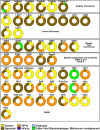Metagenomic Discovery of 83 New Human Papillomavirus Types in Patients with Immunodeficiency
- PMID: 30541782
- PMCID: PMC6291628
- DOI: 10.1128/mSphereDirect.00645-18
Metagenomic Discovery of 83 New Human Papillomavirus Types in Patients with Immunodeficiency
Abstract
Several immunodeficiencies are associated with high susceptibility to persistent and progressive human papillomavirus (HPV) infection leading to a wide range of cutaneous and mucosal lesions. However, the HPV types most commonly associated with such clinical manifestations in these patients have not been systematically defined. Here, we used virion enrichment, rolling circle amplification, and deep sequencing to identify circular DNA viruses present in skin swabs and/or wart biopsy samples from 48 patients with rare genetic immunodeficiencies, including patients with warts, hypogammaglobulinemia, infections, myelokathexis (WHIM) syndrome, or epidermodysplasia verruciformis (EV). Their profiles were compared with the profiles of swabs from 14 healthy adults and warts from 6 immunologically normal children. Individual patients were typically infected with multiple HPV types; up to 26 different types were isolated from a single patient (multiple anatomical sites, one time point). Among these, we identified the complete genomes of 83 previously unknown HPV types and 35 incomplete genomes representing possible additional new types. HPV types in the genus Gammapapillomavirus were common in WHIM patients, whereas EV patients mainly shed HPVs from the genus Betapapillomavirus. Preliminary evidence based on three WHIM patients treated with plerixafor, a leukocyte mobilizing agent, suggest that longer-term therapy may correlate with decreased HPV diversity and increased predominance of HPV types associated with childhood skin warts.IMPORTANCE Although some members of the viral family Papillomaviridae cause benign skin warts (papillomas), many human papillomavirus (HPV) infections are not associated with visible symptoms. For example, most healthy adults chronically shed Gammapapillomavirus (Gamma) virions from apparently healthy skin surfaces. To further explore the diversity of papillomaviruses, we performed viromic surveys on immunodeficient individuals suffering from florid skin warts. Our results nearly double the number of known Gamma HPV types and suggest that WHIM syndrome patients are uniquely susceptible to Gamma HPV-associated skin warts. Preliminary results suggest that treatment with the drug plerixafor may promote resolution of the unusual Gamma HPV skin warts observed in WHIM patients.
Keywords: WHIM syndrome; epidermodysplasia verruciformis; gammapapillomaviruses; metagenomic; next-generation sequencing; plerixafor; skin swabs.
Figures





References
-
- Buck CB, Ratner L. 2015. Oncogenic viruses, p 69–82. In DeVita VT, Lawrence TS, Rosenberg SA (ed), Cancer: principles & practice of oncology, 10th ed, vol 1 Lippincott Williams & Wilkins, Philadelphia, PA.
Publication types
MeSH terms
Substances
Grants and funding
LinkOut - more resources
Full Text Sources

